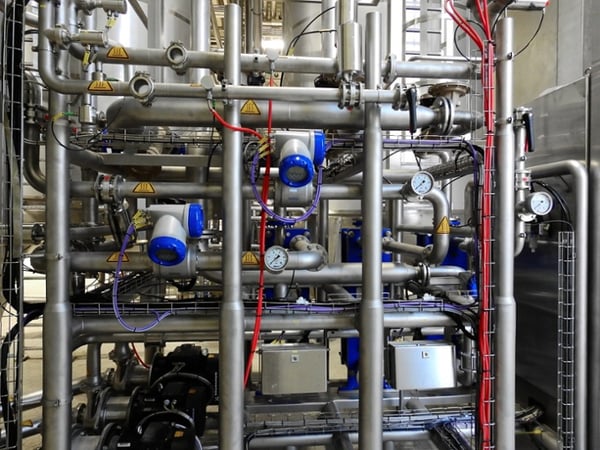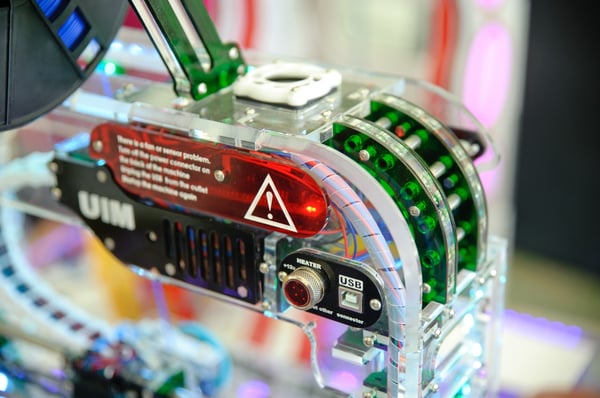The IIoT, Its Challenges And Why It's Important

Posted on Jul 30, 2019 11:33 AM. 6 min read time
Today's society is full of connected technologies ranging from smart speakers to intelligent security cameras that give you instant views of the premises from wherever you are.
Combined, all of these connected technologies comprise the Internet of Things (IoT). However, there's a subset of the IoT called the Industrial Internet of Things (IIoT). Here's everything you need to know about the IIoT and why it should matter to you.

The IIoT Explained
The IIoT allows communication between pieces of equipment via sensors. Those components can also detect specific characteristics related to an individual machine, such as operating temperature or average output per hour.
The sensors gather data and send it to the cloud, thereby allowing users to see real-time statistics from within a facility or outside of it.
You can think of the IIoT as an industrial framework where connected devices send and receive data. Some even make changes to improve performance without intervention from humans.
As such, manufacturing plants could run IIoT machines and feel confident about the results without being on site all the time.
IIoT Challenges Remain
Although people widely recognize the IIoT's potential — especially for automating tasks and increasing productivity in manufacturing — they know there are a variety of challenges to overcome. Failing to tackle those obstacles soon could hinder wider adoption of the IIoT.
Security is among the main concerns associated with the IIoT. CyberX, a company offering industrial cybersecurity strategies, published its 2019 report about IIoT risks. It found that 40 percent of industrial sites have at least one direct connection to the public internet. That leaves the entities open to external attacks that could cause their connected machinery to behave strangely.
The report also showed that more than half of those polled had outdated Windows operating systems that didn't include current security patches and other safeguards. Company representatives must realize that if they intend to embrace the IIoT, doing so means taking security seriously.
An analysis of issues in the broader IoT revealed numerous items that also apply to the IIoT. Businesses often struggle to implement IIoT technology due to a lack of unified standards, a realization that IIoT sensors won't work with legacy equipment or confusion about how to utilize IIoT tech in ways that make the most sense for business operations and customer needs.
According to a 2016 Genpact Research Institute study, the top challenge for respondents associated with implementing the IIoT was data security, followed by issues with skills shortages and legacy equipment. None are easy to overcome, but attempting to do so is essential for the IIoT to continue to prosper.
A Talent Shortage Causing Problems
An in-depth analysis of the IIoT framework maintains there is a close association between the IIoT and Industry 4.0. Tim Pawlenty is an authority on emerging technologies, including those associated with Industry 4.0, and he insists that the fourth industrial revolution, which we are now in, requires education to help people get prepared for the exceptionally fast rate of change.
So, if companies find it difficult to source people with abundant and current IIoT knowledge, they will likely discover they cannot compete against entities that do have sufficient talent on their teams. Then, even if companies are fully on board with adopting the IIoT, a lack of human resources may prevent those plans.
A study from Cisco found that 48 percent of respondents believed internal or external expertise was a crucial element for success in IoT projects. A skills shortage exists in the IoT sector at large, making recruiting people with an understanding of the IIoT niche more challenging.
Companies Must Have Defined Strategies
A lack of strategy could stop companies from realizing the potential of the IIoT, too, despite the companies wanting to use it in ways that bring measurable benefits.
A study by Emory University and Presenso, a company specializing in industrial analytics, aimed to get a multi-country perspective on the use of the IIoT in predictive maintenance.
The IIoT in that regard can potentially tell machine operators about unusual trends that indicate a failing part or another issue requiring maintenance. Having that knowledge could prevent shutdowns or at least make them less costly and extensive.
It polled people in North America, Europe, and the Asia-Pacific region and found that senior managers were more enthusiastic than operations and maintenance (O&M) professionals. Moreover, 40 percent of respondents cited a lack of strategy among the reasons for adoption delays.
The IIoT assists companies that know unplanned downtime or other kinds of system failures can cause ballooning expenses and even life-threatening issues. So, the technology matters for keeping those problems at bay. But, when companies don't know how or why to implement it, they could waste time and money on trial and error instead of solutions that make sense for the business.
Why the IIoT Matters
Data from GE Research indicates that 46 percent of the global economy could benefit from the IIoT. At the individual company level, enterprises that use IIoT tech successfully could use automation to reduce inefficiencies and errors or depend on sensor data to make smarter and more informed company decisions.
One of the highlights of IIoT data interfaces is that they typically let users look at current data, as well as historical information. Then, manufacturing plant managers can notice improvements and understand how to start addressing problems.
The IIoT can also be useful for managing delicate items, such as perishable ingredients. Sensors can give instant alerts if temperature, humidity or other environmental readings go out of the normal range.
The IIoT gives competitive advantages, as well, but only when company leaders take the time required to figure out which problems the technology could solve.
The Lean Robotics Book: A Guide To Making Robots Work In Your Factory
Tips for Bringing the IIoT Into Your Manufacturing Business
With all these things in mind, here are some steps your industrial business can take when adopting or implementing the IIoT:
- Figure out the specific obstacles in your business that the IIoT could reduce. Don't merely implement the IIoT because the option is there.
- If planning to upgrade legacy equipment for the IIoT, seek companies that specialize in that need and ask representatives for their opinions on if it's the most cost-effective to improve older equipment or buy new machines.
- Determine the largest return on investment (ROI) you can track, and come up with an IIoT analytics plan that confirms what's working well and what to change. That information gives guidance for making adjustments as the IIoT adoption period progresses.
- Make cybersecurity a priority for IIoT equipment from the start. Work with equipment companies that take cybersecurity seriously and regularly issue patches to fix vulnerabilities.
- Consider upskilling current team members to help address the skills shortage.
- Minimize IIoT risks by working with an integration partner. That entity can help you steer clear of only looking at the technology alone and instead help you see how particular IIoT technologies fit in your overall operations and future efforts.
The IIoT Brought Drastic Changes to the Manufacturing Sector
In these early stages of the IIoT, it is nonetheless clear that the technology tremendously altered how companies do business. And, it will continue to cause progress, but only after people recognize the challenges mentioned earlier and take meaningful strides in getting past them.
The tips in the previous section will help you avoid many of the most common pitfalls while deciding if IIoT implementation is right for you.



.jpg?width=600&name=Human-holding-lr-book-shop%20(1).jpg)





Leave a comment